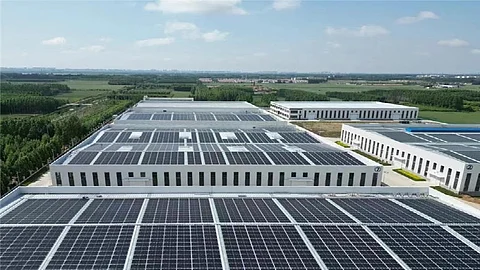

Leading solar PV manufacturer LONGi has announced that it has completed its first commercial rooftop solar project utilizing the LONGi Hi ROOF S system, developed in-house. Located in Shandong Province, the project is installed on the rooftop of a local enterprise and features LONGi’s HPBC 2.0 modules, with a total installed capacity of 3.16 MW. Over its 25-year operational life, the system is expected to generate approximately 94.07 million kWh of electricity and reduce CO₂ emissions by around 60,000 tons.
The LONGi Hi ROOF S system was officially launched at this year’s SNEC exhibition. Designed specifically for commercial & industrial (C&I) rooftops, the company says the system integrates high-efficiency power generation, enhanced safety protection, broad compatibility, and intelligent system management. It adds that the system aims to elevate solar installations from simple energy infrastructure to integral architectural components.
Earlier this week, LONGi’s Hi-MO X10 modules scored top rating from TÜV Rheinland for shading resistance (see China Solar PV News Snippets).
Solar equipment manufacturer SC Solar has announced its plans to invest RMB 150 million ($20.83 million) in solar cell and module producer Runergy, by subscribing to new shares. Upon completion, SC Solar will hold 8,437,500 shares, representing 1.5523% of Runergy’s total equity post-conversion.
The investment is conditional on Runergy or its affiliates repaying a debt of $20.83 million owed to SC Solar. According to the announcement from SC Solar’s parent company, J.S.Machine, if the debt is not repaid as agreed, SC Solar reserves the right to convert the outstanding cash contribution into equity based on the creditor relationship with Runergy.
Last month, Gaoce Intelligent announced that it will convert RMB 100 million ($13.87 million) in receivables into equity in Runergy, acquiring a 1.0817% stake in the company (see China Solar PV News Snippets).
According to data released by the National Energy Administration (NEA), China issued 215 million green power certificates in May 2025, a 0.59% decrease month-over-month. Of these, 40.55 million were for solar power generation projects.
Cumulatively, from January to May 2025, a total of 1.093 billion green certificates were issued, including 210 million specifically for solar power. Green certificates are part of China’s market-based mechanism to promote renewable electricity consumption and track the environmental attributes of clean energy.
China’s National Forestry and Grassland Administration, National Development and Reform Commission (NDRC), and National Energy Administration (NEA) have jointly issued a master plan for PV-driven desertification control across the ‘Three-North’ desert regions (northern, northwestern, and northeastern China) from 2025 to 2030. By 2030, the plan targets the addition of 253 GW of installed solar capacity for desertification control, while restoring approximately 6.73 million hectares (101 million mu) of degraded land.
The plan promotes a dual focus on ecological restoration and renewable energy development by integrating desertification prevention with solar and wind power deployment. It envisions a large-scale ‘Great Wall of Solar’ across central Inner Mongolia to western Xinjiang through a combination of pilot projects and utility-scale installations.
